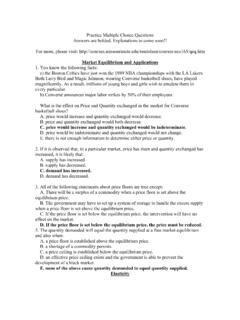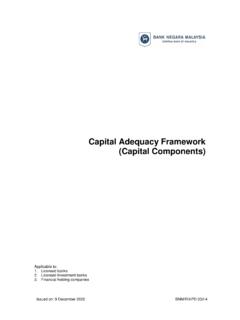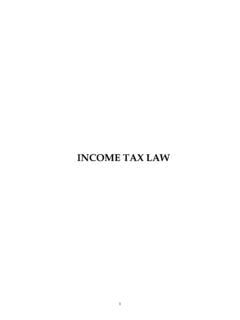Transcription of Three models of market impact - Baruch MFE Program
1 Introduction Square-root law models Model implications Conclusion Three models of market impact Jim Gatheral market Microstructure and High-Frequency Data Chicago, May 19, 2016. Introduction Square-root law models Model implications Conclusion Overview of this talk The optimal execution problem The square-root law of market impact Three models compatible with the square-root law The continuous time propagator model The Alfonsi and Schied order book model The locally linear order book (LLOB) model Model-dependence of the impact profile Introduction Square-root law models Model implications Conclusion Overview of execution algorithm design Typically, an execution algorithm has Three layers: The macrotrader This highest level layer decides how to slice the order: when the algorithm should trade, in what size and for roughly how long. The microtrader Given a slice of the order to trade (a child order), this level decides whether to place market or limit orders and at what price level(s).
2 The smart order router Given a limit or market order, which venue should this order be sent to? In this talk, we are concerned with the highest level of the algorithm: How to slice the order. Introduction Square-root law models Model implications Conclusion Statement of the problem Given a model for the evolution of the stock price, we would like to find an optimal strategy for trading stock, the strategy that minimizes some cost function over all permissible strategies. In all the models we will consider, the optimal strategy does not depend on the stock price and so may be determined in advance of trading. The reason was given by Predoiu, Shaikhet and Shreve. Introduction Square-root law models Model implications Conclusion Predoiu, Shaikhet and Shreve Suppose the cost associated with a strategy depends on the stock price only through the term Z T. St dxt . 0. with St a martingale. Integration by parts gives Z T Z T.
3 E St dxt = E ST xT S0 x0 xt dSt = S0 X. 0 0. which is independent of the trading strategy and we may proceed as if St = 0. Quote from [Predoiu, Shaikhet and Shreve]..there is no longer a source of randomness in the problem. Consequently, without loss of generality we may restrict the search for an optimal strategy to nonrandom functions of time . Introduction Square-root law models Model implications Conclusion Practical implication Given a model which does not satisfy the conditions of Prediou, Shaikhet and Shreve, we can always find a similar model that does. Because the stock price does not mover very much over the course of a typical algorithmic execution, the optimal strategies will typically barely differ. See [Gatheral and Schied] for a specific example of this. Introduction Square-root law models Model implications Conclusion The square-root formula for market impact For many years, traders have used the simple sigma-root-liquidity model described for example by Grinold and Kahn in 1994.
4 Software incorporating this model includes: Salomon Brothers, StockFacts Pro since around 1991. Barra, market impact Model since around 1998. Bloomberg, TCA function since 2005. The model is always of the rough form r Q. P = Spread cost + . V. where is daily volatility, V is daily volume, Q is the number of shares to be traded and is a constant pre-factor of order one. Introduction Square-root law models Model implications Conclusion Empirical question So traders and trading software have been using the square-root formula to provide a pre-trade estimate of market impact for a long time. Empirical question Is the square-root formula empirically verified? Introduction Square-root law models Model implications Conclusion impact of proprietary metaorders (from To th et al.). Figure 1: Log-log plot of the volatility-adjusted price impact vs the ratio Q/V. Introduction Square-root law models Model implications Conclusion Notes on Figure 1.
5 In Figure 1 which is taken from [To th et al.], we see the impact of metaorders for CFM1 proprietary trades on futures markets, in the period June 2007 to December 2010. impact is measured as the average execution shortfall of a meta-order of size Q. The sample studied contained nearly 500,000 trades. We see that the square-root market impact formula is verified empirically for meta-orders with a range of sizes spanning two to Three orders of magnitude! The square-root formula is so widely accepted as offering a good description of the data that we will often refer to it as the square-root law. 1. Capital Fund Management (CFM) is a large Paris-based hedge fund. Introduction Square-root law models Model implications Conclusion Some implications of the square-root formula The square-root formula refers only to the size of the trade relative to daily volume. It does not refer to for example: The rate of trading How the trade is executed The capitalization of the stock Surely impact must be higher if trading is very aggressive?
6 The database of trades only contains sensible trades with reasonable volume fractions. Were we to look at very aggressive trades, we would indeed find that the square-root formula breaks down. Introduction Square-root law models Model implications Conclusion Compatible dynamics We will now present Three different models whose dynamics are compatible with the square-root formula The continuous time propagator model The Alfonsi and Schied order book model The locally linear order book (LLOB) model In particular, for each of these models , we will focus on qualitative features of the optimal liquidation strategy. Introduction Square-root law models Model implications Conclusion Price manipulation A trading strategy = {xt } is a round-trip trade if Z T. x t dt = 0. 0. Definition A price manipulation is a round-trip trade whose expected cost C [ ] is negative. You would want to repeat such a trade over and over.
7 If there is price manipulation, there is no optimal strategy. Introduction Square-root law models Model implications Conclusion Transaction-triggered price manipulation Definition (Alfonsi, Schied, Slynko (2009)). A market impact model admits transaction-triggered price manipulation if the expected costs of a sell (buy) Program can be decreased by intermediate buy (sell) trades. As discussed in [Alfonsi, Schied and Slynko], transaction-triggered price manipulation can be regarded as an additional model irregularity that should be excluded. Transaction-triggered price manipulation can exist in models that do not admit standard price manipulation in the sense of the Huberman and Stanzl definition. Introduction Square-root law models Model implications Conclusion Test The continuous time propagator model In this model from [Gatheral], the stock price St at time t is given by Z t Z t St = S0 + f (x s ) G (t s) ds + dZs (1).
8 0 0. where x s is our rate of trading in dollars at time s < t, f (x s ). represents the impact of trading at time s and G (t s) is a decay factor. St follows an arithmetic random walk with a drift that depends on the accumulated impacts of previous trades. The cumulative impact of (others') trading is implicitly in S0. and the noise term. Drift is ignored. Introduction Square-root law models Model implications Conclusion Test We refer to f ( ) as the instantaneous market impact function and to G ( ) as the decay kernel. (1) is a generalization of processes previously considered by Almgren, Bouchaud and Obizhaeva and Wang. Remark The price process (1) is not the only possible generalization of price processes considered previously. On the one hand, it seems like a natural generalization. On the other hand, it is not motivated by any underlying model of the order book. Introduction Square-root law models Model implications Conclusion Test Cost of trading Denote the number of shares outstanding at time t by xt.
9 Then from (1), the expected cost C associated with a given trading strategy is given by Z T Z t C= x t dt f (x s ) G (t s) ds (2). 0 0. The dxt = x t dt shares liquidated at time t are traded on average at a price Z t St = S0 + f (x s ) G (t s) ds 0. which reflects the residual cumulative impact of all prior trading. Introduction Square-root law models Model implications Conclusion Test The square-root model Consider the following special case of (1) with f (v ) = 34 . p v /V.. and G ( ) = 1/ : Z t r 3 vs ds St = S0 + + noise (3). 4 0 V t s which we will call the square-root process. It is easy to verify that under the square-root process, the expected cost of a VWAP execution is given by the square-root law for market impact : r C Q. = (4). Q V. Of course, that doesn't mean that the square-root process is the true underlying process! Introduction Square-root law models Model implications Conclusion Test The optimal strategy under the square-root process In [Curato et al.]
10 ], we show that this model admits both transaction-triggered price manipulation and price manipulation. There is no optimal strategy. We show numerical evidence that this problem may be mitigated by introducing a bid-ask spread cost or by imposing convexity of the instantaneous market impact function for large trading rates The objective in each case is to robustify the solution in a parsimonious and natural way. Introduction Square-root law models Model implications Conclusion Test The lowest cost strategies Figure 2: The four lowest cost solutions from brute-force minimization of the square-root model cost functional (2) with 10% participation rate. The costs are reported in the insets. Introduction Square-root law models Model implications Conclusion Test Comments on Figure 2. All of the lowest cost solutions are characterized by a few intense positive spikes, separated by periods of slow selling. If we impose that a strategy should be monotone (no wrong-way trading), qualitatively similar strategies involving short bursts of trading separated by periods of inactivity have significantly lower expected cost than VWAP in the propagator model.






